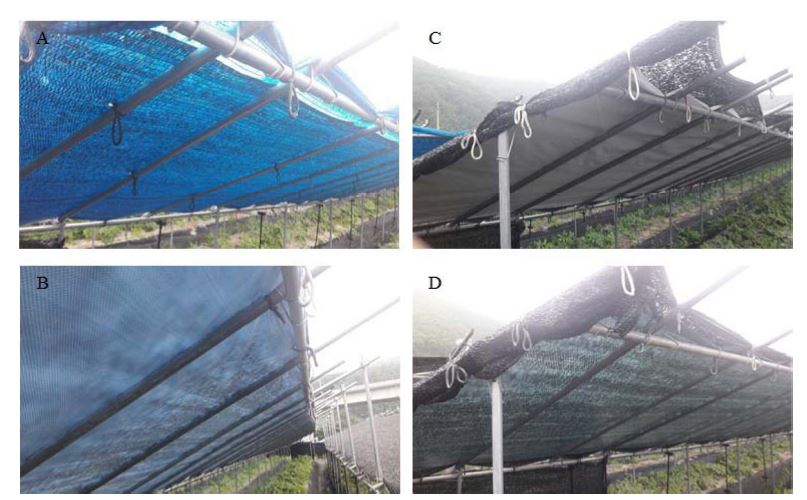
인삼 차광자재별 미기상 및 고온피해 발생 비교 분석
This is an open access article distributed under the terms of the Creative Commons Attribution Non-Commercial License (http://creativecommons.org/licenses/by-nc/3.0/) which permits unrestricted non-commercial use, distribution, and reproduction in any medium, provided the original work is properly cited.
Abstract
High temperature damage in ginseng is influenced by shading materials related not only to temperature, but also to light intensity and light quality. To address, this green-colored khaki shading sheet is widely used. As they are recently, developed, there is limited research information about their attributes and use.
The four-layered shading net (FLSN), blue-colored shading sheet (BCSS), aluminum-coated shading board (ACSB), and green-colored shading sheet (GCSS) were installed in the wooden A type of sun-block facilities. Two layered black, shading net was additionally used to cover the facilities since the beginning of June. The average temperature at the facility where different shades were tested was in the order of BCSS (28.9℃) > FLSN (27.7℃) > GCSS (27.6℃) > ACSB (27.1℃). However, high temperature injury rates were in order: FLSN > ACSB > GCSS > BCSS. Root weight vaired and was in the order: ACSB > GCSS > BCSS > FLSN.
High temperature damage is possible not only because of temperature increase, but also due to various environmental light factors. Ginseng high temperature injury was minimal when BCSS or GCSS were used by difference of light quality. Although the root weight was higher in ACSB, it could be vulnerable to high temperature damage. Therefore, we propose using GCSS for ginseng shading.
Keywords:
Panax ginseng C. A. Meyer, Ginseng, High Temperature Injury, Microclimate, Shading Material서 언
인삼 (Panax ginseng C. A. Meyer)은 두릅나무과(Araliaceae)에 속하는 여러해살이 반음지성 식물로 고온 또는 강한 빛에 노출되면 엽소 현상이 일어나 해가림 시설이 필수적이다.
과거에는 차광자재로 볏짚을 사용하였으나 부숙되기 쉽고 투과되는 광량이 적어 1980년대부터 polyethylene (PE)으로 만든 피복물이 차광재로 널리 쓰이고 있다. 그중 흑색 3 중직 차광망부터 청색 3 겹 + 흑색 1 겹의 4 중직 차광망 순으로 사용됐는데 망 사이의 누수로 적변삼과 점무늬병 등이 많이 발생하는 단점이 있어 (Kim and Lee, 2002) 빗물의 직접적인 유입을 막아 토양의 과습과 병의 발생을 줄이기 위하여 다양한 종류의 차광지가 농가에 보급되고 있다 (Lee, 2007b).
한편, 인삼은 전엽 후 최적 생육 기온은 21 - 25℃의 비교적 저온으로 30℃ 이상에서는 광합성 효율이 급격히 감소 되며 30℃ 이상의 온도가 7 일 이상 지속 되면 고온장해가 나타난다고 하였다 (Lee et al., 2010). 고온장해 시 인삼 잎은 가장자리부터 서서히 타들어 가고 심한 경우 잎이 탈락되면서 생장을 멈춘다 (Lee et al., 2012). 게다가 여름철 고온기에 외부 기온이 30℃ 이상일 경우 해가림 시설 내 기온은 구조상 외부 기온보다 3 - 4℃ 정도 높은 33 - 34℃까지 상승되어 고온 피해에 더욱 취약한 실정이다 (An et al., 2009).
지구 온난화로 이상고온이 상시화된 요즘 인삼 고온 피해 면적은 매년 증가하고 있는 추세이다. 무더위 초기에는 3년생 미만의 저년근 위주로 발생하다가 점차 4 - 6년근으로 확대되고 폭염이 장기간 지속됨에 따라 산간 또는 고위도 지역에서도 고온 피해가 발생된다. 고온피해가 심한 경우 수분 부족과 염류농도 상승이 동반되어 지상부가 고사하며 일부 인삼에서 뿌리썩음이 발생되기도 했다 (RDA, 2014).
인삼 고온피해는 온도뿐만 아니라 광량 또는 광질과도 연관되어 있어 해가림용 차광자재의 영향을 많이 받았다 (Jang et al., 2015; Jang et al., 2016). Lee 등 (2013)은 차광자재별 인삼 수량을 조사한 결과 청색 차광지 > 은박 차광판 > 4중직 차광망 순으로 보고하였고 청색 차광지의 내부 유입 광량이 많았지만 광질 특성으로 인해 고온피해를 덜 받았다고 추정하였다. 또한 Panax quinquefolium 잎의 황화정도는 적색 > 흰색 > 청색 > 황색 > 녹색 순이라는 연구결과도 있어 차광자재에 따른 광질 차이가 고온 피해를 경감시키는 요인이 되는 것으로 보고하였다 (Lee et al., 1999). 이 같은 이유로 최근 충청도와 경기도 일대에서 녹색 계열의 국방색 차광지가 널리 사용되고 있지만 새로 개발된 차광자재인 만큼 관련 연구결과가 없는 실정이다.
따라서 본 연구는 4 중직 차광망, 청색 차광지, 은박 차광판, 녹색 차광지 등 4 종의 차광자재를 해가림 시설에 설치하고 내부 미기상 및 엽록소 함량 변화를 조사하여 인삼 고온 피해 경감을 위한 기초 자료를 마련코자 하였다.
재료 및 방법
포장조성
시험포장에서 2 년간 예정지관리 후 2018년 3월 경 이랑과 고랑의 넓이를 각각 90 ㎝ 씩 두둑 높이는 30 ㎝로 조성하였다. 두둑 방향은 동서 방향에서 남으로 약 20℃의 편각을 두었으며 4 월 초순에 0.8 g 내외의 균일한 묘삼 (Panax ginseng Meyer)을 7 행 10 열 (70 주/3.3 ㎡)로 이식하였다.
차광조건
철재 A형 해가림시설에 차광자재로 4 중직 차광망, 청색 차광지, 은박 차광판, 녹색 차광지를 설치하고 온도가 높아지기 시작하는 6 월 상순부터 흑색 2 중직 차광망을 약 20 ㎝ 가량 띄워 추가 피복하였다 (Fig. 1). 시험 배치는 난괴법 3 반복이었고 처리별 면적은 구당 16.5 ㎡였다.
미기상조사
고온기 차광자재별 내부로 유입되는 광질은 MK350S (UPRtek, Miaoli County, Taiwan)로 투광량은 Li-1400 data logger (Li-COR, Lincoln, NE, USA)로 측정하였다. 대기 온도는 Thermo Recorder TR-72Ui (T&D Co., Tokyo, Japan)를 차광자재 한 가운데에 붙인 상태와 인삼 (Panax ginseng C. A. Meyer) 잎 높이 부근인 지상 25 ㎝에 설치하여 측정하였다. 투광량과 기온은 날이 맑고 온도가 가장 높았던 8 월 13 일부터 17 일까지 5 일간의 평균값을 조사하였다.
생육 및 고온피해 발생정도 조사
차광자재별 엽록소 함량은 SPAD-502 (Minolta, Tokyo, Japan)로 두둑 중간에 있는 인삼의 가운데 잎을 10 반복하여 측정하였다. 측정 시기는 추가 피복을 한 6 월 초부터 고온기가 끝나는 9 월 초까지 약 30 일 간격으로 하였다. 10 월 하순, 차광자재 처리별 인삼을 수확 후 digimatic calipers (caliper 500-182, Mitutoyo, Tokyo, Japan)와 electronic scale (RE260, CAS, Seoul, Korea)로 근장, 근직경, 근중 등 뿌리 생육을 조사하였다. 고온 피해 발생 정도는 3.3 ㎡당 생육 주수 대비 육안으로 확인했을 때 10% 이상 엽면적이 타 들어간 주 수를 나눠 발생률을 산정하였다.
통계처리
모든 분석은 SAS 프로그램 (SAS v9.4, SAS Institute Inc., Cary, NC, USA)을 이용하여 분산분석 (ANOVA)을 실시 한 후 처리 간에 차이가 있을 경우 5% 유의수준에서 Duncan’s Multiple Range Test (DMRT)로 분석하였다 (p < 0.05).
결과 및 고찰
차광조건에 따른 미기상 특성 분석
차광자재별 내부로 유입되는 380 ㎚ - 780 ㎚ 영역대의 파장은 Fig. 2과 같다. 4 중직 차광망은 상대적 광 세기가 477 ㎚에서 가장 높았다가 719 ㎚의 4.87%까지 낮아진 후 다시 증가하는 추세였다. 청색 차광지는 녹색 차광지보다 청색광을 제외한 500 ㎚ - 780 ㎚의 영역에서 상대적 광 세기가 낮았지만 패턴은 유사하였다. 은박 차광판은 687 ㎚부터 증가하여 780 ㎚가 가장 높아 다른 차광자재와 달리 장파장 영역의 빛 세기가 증가하여 고온에서 잎 표면의 상승시킬 수 있는 광질이었다.
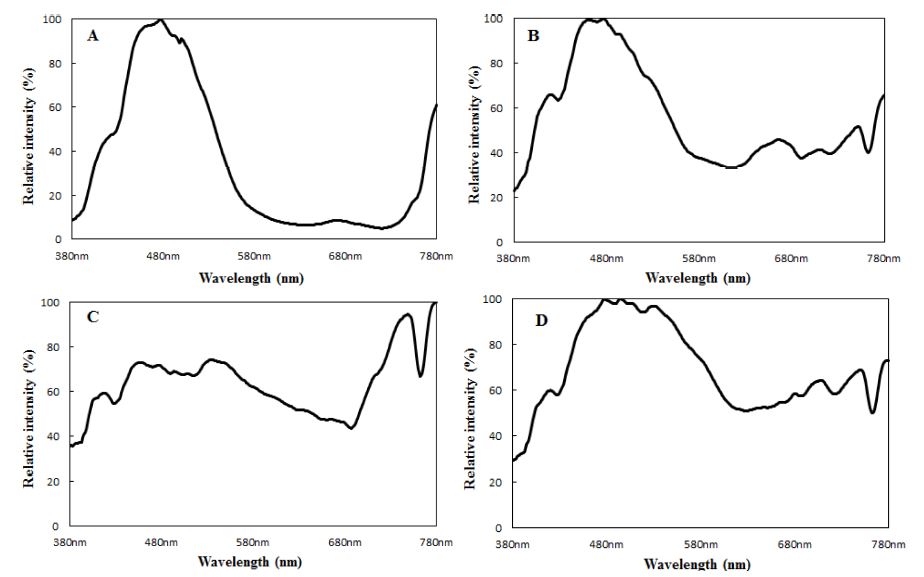
Spectral properties measured at 1,000 - 1,100 umol/m2/s (outside quantum) under shading materials after covering black two-layered shading net.A; four-layered shading net, B; blue color shading sheet, C; aluminum-coated shading board, D; green color shading sheet.
오전 6 시부터 8 시까지의 외부 광량은 600 umol/㎡/s 미만에서 1,650 umol/㎡/s까지 증가하다 다시 감소하여 맑은 날에 주로 나타나는 전형적인 종 모양의 일사 변화를 나타내었다. 반면 해가림 시설 내 두둑 가운데서 측정된 내부 광량은 차광자재에 상관없이 오전 7 시는 280 umol/㎡/s에 최고의 광량을 보였고 오전 8 시는 140 umol/㎡/s로 다시 낮아졌고 9 시 경까지 감소하다 이후에는 일몰까지 일정한 수준의 광량을 유지하였다 (Fig. 3).

Average photosynthetic active radiation at outside (A) and the center rows (B) of ginseng bed depending on shading materials from August 13 to 17, 2018.FLSN; four-layered shading net, BCSS; blue color shading sheet, ACSB; aluminum-coated shading board, GCSS; green color shading sheet.
해가림 시설의 구조적 특성상 해의 이동 경로에 따라 광이 두둑 내부로 깊숙이 들어오는데 한여름인 8 월경에는 오전 9시 후에 직사광이 차단되었다. 이는 두둑 후주를 제외하고 4월 - 5 월에도 오전 6 시부터 8 시까지의 유입 광량이 8 시 이후보다 2 - 3 배 정도 많다는 연구결과와 일치하였다 (An et al., 2009). 오전 9 시부터는 외부와 비교하여 내부 광량이 투과율 개념으로 유입되었는데 녹색 차광지 (6.7%) > 4 중직 차광망 (6.4%) > 청색 차광지 (4.6%) > 은박 차광판 (4.5%)순이었다. 차광자재에 상관없이 유입된 오전의 강한 광량은 온도가 낮은 환경에서 광합성 효율을 보다 증대시키지만 (Hyun et al., 1993) 고온기에는 인삼의 광포화점이 낮아지며 고온장해를 촉진시킬 수 있다 (Lee, 2007a).
오전 8 시부터 오후 7 시까지 차광자재 근접부의 평균 온도는 청색 차광지 (31.5℃) > 녹색 차광지 (30.3℃) > 4 중직 차광망 (30.1℃) > 은박 차광판 (28.8℃) 순으로 인삼 잎 높이의 평균 온도인 청색 차광지 (28.9℃) > 4 중직 차광망 (27.7℃) > 녹색 차광지 (27.6℃) > 은박 차광판 (27.1℃)과 비슷한 경향이었다 (Fig. 4). 특히 최고온도는 잎 부근이 청색 차광지 (38.7℃) > 4 중직 차광망 (37.4℃) > 녹색 차광지 (35.2℃) > 은박 차광판 (34.3℃) 순이었는데, 알루미늄의 특성상 복사에너지를 대부분 반사하고 다른 자재의 경우는 색상과 차광자재의 물성에 따라 단파복사를 흡수, 다시 장파복사 형태로 방출하기 때문으로 판단된다. 열전도는 얇은 곳에서 쉽게 일어나 자재 두께의 영향을 받는데 4 중직 차광망의 경우 자재는 두꺼워도 망의 형태로 구성되어 있어 흡수한 열을 공간 사이로 빼앗겨 온도 변화가 컸던 것으로 유추된다.
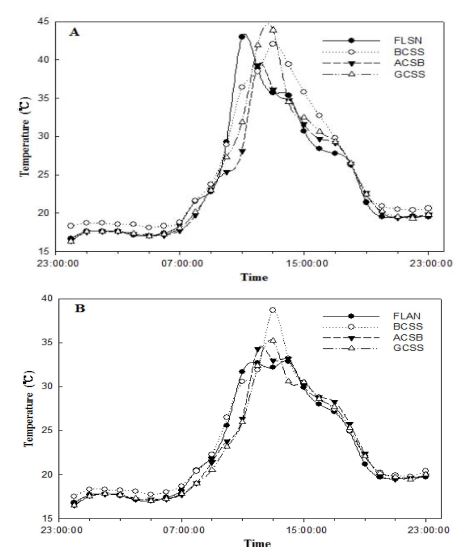
Time-based average temperature response at just below the facility (A) and near the leaves (B) depending on shading materials from August 13 to 17, 2018.FLSN; four-layered shading net, BCSS; blue color shading sheet, ACSB; aluminum-coated shading board, GCSS; green color shading sheet.
차광지는 청색이 녹색보다 광투과율이 약간 낮음에도 온도가 높은 경향이었다. 차광망 중 청색이 검정색 (Mok et al., 1994) 또는 노란색 (Lee et al., 2007)보다 시설 내 대기온도가 높았다는 선행 연구결과와 유사하였다. 태양으로부터 단파복사에너지가 유입될 때 차광자재의 특성에 따라 단파복사의 흡수 및 방출 그리고 흡수된 단파복사에너지를 장파복사로 보유 또는 방출하게 된다 (Jung et al., 2011).
알루미늄은 단파복사와 장파복사의 복사수지 분석 시 알베도 비율이 0.83으로 단파 및 장파복사를 대부분 반사하고 합성섬유 재질의 인조잔디는 단파복사의 반사가 거의 없고 흡수한 빛의 장파복사 방출량은 많았다고 하였다 (Choi and Lee, 2008; Choi and Lee, 2010). 따라서 온도 차이는 차광자재의 복사수지 및 열 특성에 영향을 받았고 방출된 복사에너지는 식물체에 빛에너지로 전달되어 엽온 상승을 유발시킬 수 있다.
차광조건에 따른 인삼 생육 및 고온발생 정도
폭염에 대비해 흑색 2 중직 차광망을 덧씌우기 전인 6 월 4 일, 차광자재별 인삼의 SPAD 평균값은 은박 차광판만 31.8로 다른 처리구들보다 엽록소 함량이 낮았다 (Fig. 5). 은박의 특성상 빛이 반사되었기 때문으로 보이며 피해를 줄이기 위해서는 은박 차광판 설치 시 후주 연결 부위를 높여 약 24℃의 해가림 경사를 보다 낮추는 게 필요할 것이다. 폭염이 시작된 7월 2 일부터 4 중직 차광망의 엽록소 함량이 급격히 낮아져 9 월 5 일까지 청색 차광지 > 녹색 차광지 > 은박 차광판 > 4 중직 차광망의 순서가 유지되었다.
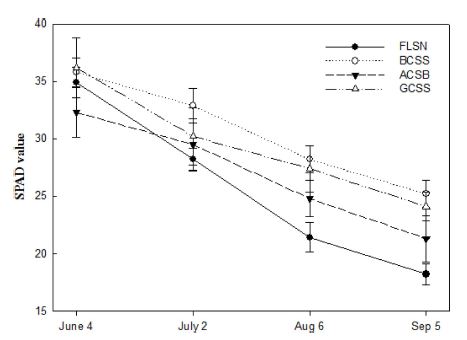
SPAD value of 2-years-old Panax ginseng grown under different shading materials at the indicated days.The vertical error bars represent the standard errors (n = 10). FLSN; four-layered shading net, BCSS; blue color shading sheet, ACSB; aluminum-coated shading board, GCSS; green color shading sheet.
9 월 5 일 경 조사한 고온장해 발생률은 엽록소 함량이 낮은 순으로 높았는데, 피해 발생정도는 차이가 보다 분명했다 (Fig. 6). 청색 차광지 (6.9%)와 녹색 차광지 (8.6%)는 유의적인 차이가 없었지만 은박 차광판과 4 중직 차광망은 30%가 넘는 고온피해를 입었다. 은박 차광판의 경우 자재 특성상 가장 낮은 대기 온도가 조성되었지만 고온피해를 많이 입은 데는 기존의 광 반사뿐만 아니라 방출된 복사에너지가 인삼 잎의 엽온 상승을 유발시켰기 때문으로 보였다.
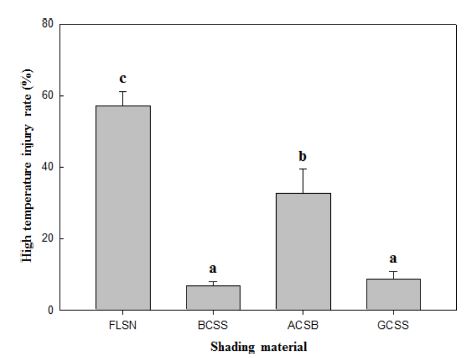
High temperature injury rate of 2-years-old Panax ginseng grown under different shading materials on September 10, 2018.The vertical error bars represent the standard errors (n = 3). The same letters at the top of each bar indicate statistically no difference at p < 0.05 using Duncan’s Multiple Range Test (DMRT). FLSN; four-layered shading net, BCSS; blue color shading sheet, ACSB; aluminum-coated shading board, GCSS; green color shading sheet.
당해년도 수확 후 뿌리 생체중은 은박 차광판 > 녹색 차광지 > 청색 차광지 > 4 중직 차광망 순서로 높았다 (Table 1). 은박 차광판 내 인삼에서 고온피해가 발생했음에도 생체중이 가장 높은 건, 청색광보다 적색광에서 광합성효율이 17% 가량 높고 생체중은 20% 증가한다는 기존 연구결과로 해석된다 (Yu et al., 2005). 반면 4 중직 차광망의 경우, 고온피해 뿐만 아니라 누수가 발생되기 쉬운 환경으로 생체중에 영향을 미친 것으로 보였다 (Kim et al., 2010).

Growth characteristics of the subterranean part of 2-years-old Panax ginseng grown at different shading materials in a conventional facility.
본 연구결과, 차광자재의 미기상에 따라 인삼의 고온 피해 발생 양상이 변하는 것을 확인하였다. 위 결과들을 종합하여 볼 때 시설 내 온도는 자재 특성에 결정되는 듯하며 은박 차광판이 복사에너지 반사 및 열전도율이 낮은 알루미늄의 특성상 시설 내부 온도가 상대적으로 낮았다. 온도뿐만 아니라 광질 등 여러 환경 요인에 따라 고온 피해는 발생될 수 있는데 청색 또는 녹색차광지 내 인삼의 피해가 적었다. 뿌리 생체중은 은박 차광판 내 인삼이 높았으나 고온 피해에 취약할 수 있어 녹색차광지를 이용하는 것이 좋을 것으로 판단된다. 고착화되는 폭염에 대응하여 녹색 계열의 차광판을 개발하거나 오전 입사광을 줄이도록 재배법을 개선하는 등 향후 추가적인 연구도 병행되어야 할 것이다.
Acknowledgments
본 연구는 농촌진흥청 연구사업(과제번호: PJ01432302)의 지원에 의해 이루어진 결과로 이에 감사드립니다.
References
- An, YN, Choung, MG, and Kang, KH, (2009), Changes of microclimate responses and chlorophyll content(SPAD) to different shading materials on Korean ginseng(Panax ginseng C. A. Meyer) Bed, Korean Journal of Crop Science, 54, p397-406.
- Choi, DH, and Lee, BY, (2008), A study of the thermal characteristics of flooring materials, wood, rock, aluminum through observation of its radiant environment in the summer, Journal of the Korean Solar Energy Society, 28, p35-44.
- Choi, DH, and Lee, BY, (2010), An experimental study of surface materials for planting of building surface by the radiant heat balance analysis in the summer, Journal of the Korean Solar Energy Society, 30, p71-80.
- Hyun, DY, Hwang, JK, Choi, SY, and Jo, JS, (1993), Photosynthetic characteristics of Panax ginseng C.A. Meyer I. Photosynthetic response to changes of light intensity and leaf temperature, Korean Journal of Ginseng Science, 17, p240-245.
-
Jang, IB, Lee, DY, Yu, J, Park, HW, Mo, HS, Park, KC, Hyun, DY, Lee, EH, Kim, KH, and Oh, CS, (2015), Photosynthesis rates, growth, and ginsenoside contents of 2-yr-old Panax ginseng grown at different light transmission rates in a greenhouse, Journal of Ginseng Research, 39, p345-353.
[https://doi.org/10.1016/j.jgr.2015.03.007]

- Jang, IB, Yu, J, Kweon, KB, and Suh, SJ, (2016), Effect of controlled light environment on the growth and ginsenoside content of Panax ginseng C. A. Meyer, Korean Journal of Medicinal Crop Science, 24, p277-283.
-
Jung, IS, Choi, DH, and Lee, BY, (2011), Analysis of radiative characteristics at urban area by observation in summer season, Journal of the Korean Solar Energy Society, 31, p133-144.
[https://doi.org/10.7836/kses.2011.31.3.133]

-
Kim, HK, and Lee, KS, (2002), Effect of coverings on the growth of ginseng and the persistency of procymidone in growing soils, Korean Journal of Environmental Agriculture, 21, p24-30.
[https://doi.org/10.5338/kjea.2002.21.1.024]

-
Kim, YC, Lee, JH, Bae, YS, Sohn, BK, and Park, SK, (2010), Development of effective environmentally-friendly approaches to control Alternaria blight and anthracnose diseases of Korean ginseng, European Journal of Plant Pathology, 127, p443-450.
[https://doi.org/10.1007/s10658-010-9610-4]

- Lee, CY, (2007a), Characteristics of photosynthesis with growing stages by different shading materials in Panax ginseng C. A. Meyer, Korean Journal of Medicinal Crop Science, 15, p276-284.
- Lee, CY, (2007b), Effects of shading material of rain shelter on growth and quality in Panax ginseng C. A. Meyer, Korean Journal of Medicinal Crop Science, 15, p291-295.
-
Lee, JS, Lee, DY, Lee, JH, Ahn, IO, and In, JG, (2012), Photosynthetic characteristics of resistance and susceptible lines to high temperature injury in Panax ginseng Meyer, Journal of Ginseng Research, 36, p461-468.
[https://doi.org/10.5142/jgr.2012.36.4.461]

- Lee, SS, Proctor, JTA, and Choi, KT, (1999), Influence of monochromatic light on photosynthesis and leaf bleaching in Panax species, Journal of Ginseng Research, 23, p1-7.
- Lee, SW, Kim, GS, Lee, MJ, Hyun, DY, Park, CG, Park, HK, and Cha, SW, (2007), Effect of blue and yellow polyethylene shading net on growth characteristics and ginsenoside contents in Panax ginseng C. A. Meyer, Korean Journal of Medicinal Crop Science, 15, p194-198.
-
Lee, SW, Park, KC, Lee, SH, Kim, GS, Jang, IB, Kim, YB, and Cha, SW, (2013), Growth characteristics and ginsenoside contents of 6-year-old ginseng(Panax ginseng C. A. Meyer) by shade materials in paddy field, Korean Journal of Medicinal Crop Science, 21, p118-123.
[https://doi.org/10.7783/kjmcs.2013.21.2.118]

- Mok, SK, Cheon, SK, Lee, SS, and Lee, TS, (1994), Effect of shading net colors on the growth and saponin content of Korean ginseng(Panax ginseng C. A. Meyer), Korean Journal of Ginseng Science, 18, p182-186.
-
Lee, JS, Lee, JH, and Ahn, IO, (2010), Characteristics of resistant lines to high temperature injury in ginseng(Panax ginseng C. A Meyer), Journal of Ginseng Research, 34, p274-281.
[https://doi.org/10.5142/jgr.2010.34.4.274]

- Rural Development Adminstration(RDA), (2014), Ginseng, Rural Development Adminstration, Eumseong, Korea, p40-48.
-
Yu, KW, Murthy, HN, Hahn, EJ, and Paek, KY, (2005), Ginsenoside production by hairy root cultures of Panax ginseng: Influence of temperature and light quality, Biochemical Engineering Journal, 23, p53-56.
[https://doi.org/10.1016/j.bej.2004.07.001]


